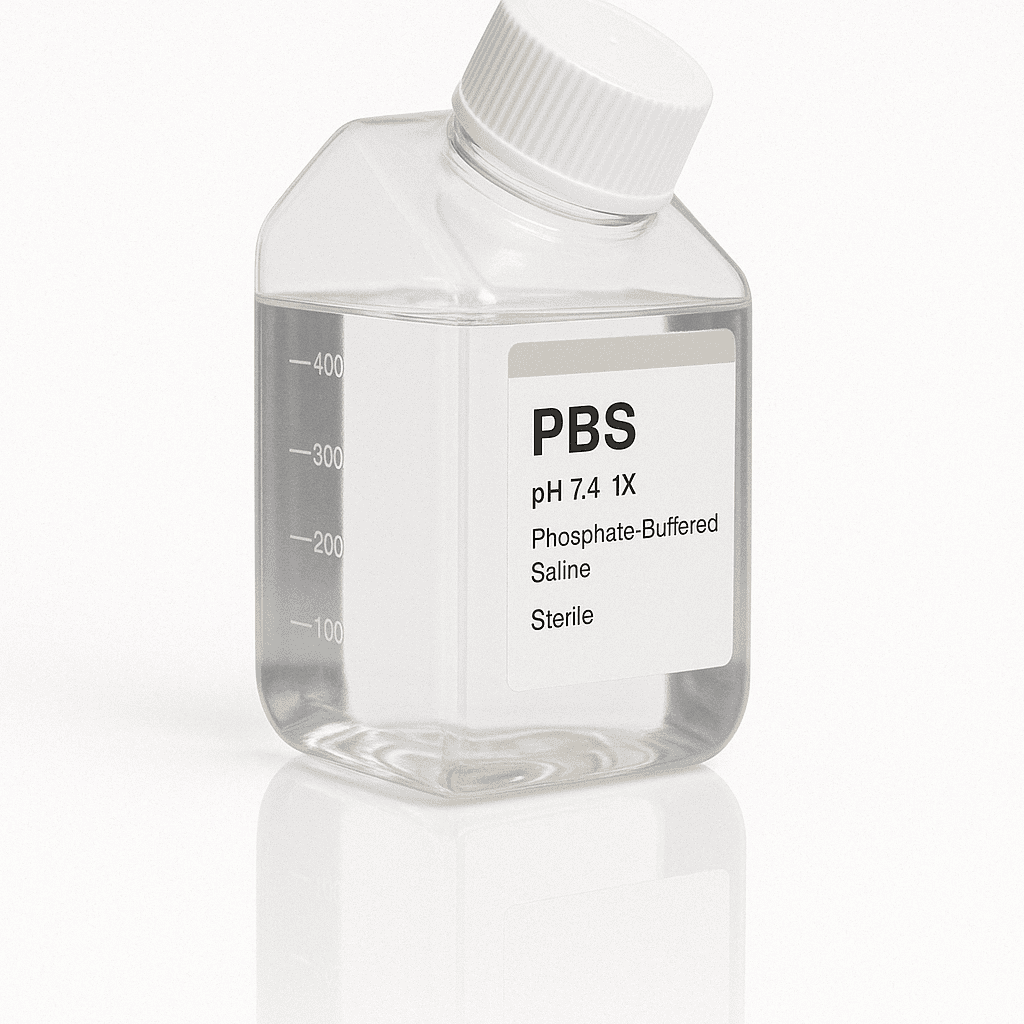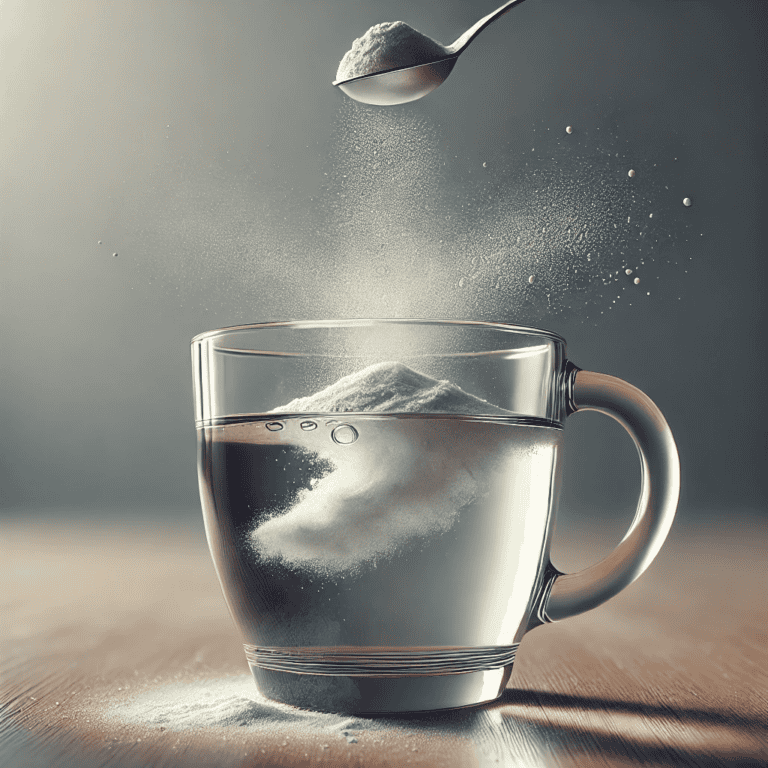How to Make Phosphate Buffered Saline (PBS)
What is Phosphate Buffered Saline?
Phosphate buffered saline (PBS) is a special saltwater solution used in science labs. It is a buffered solution, which means it can keep its pH (acidity) steady. The pH of PBS is about 7.4, similar to the inside of our bodies. PBS contains common salts like sodium chloride (the same as table salt) and phosphate. The amount of salt in PBS is balanced to match the salt in our cells. In other words, it is isotonic with the human body (it has a similar salt concentration as our blood). This balance is why PBS is gentle for living cells.

Materials Needed (Traditional Method)
To make PBS from scratch in a school lab, you will need:
- Sodium chloride (NaCl) – ~8 g
- Potassium chloride (KCl) – ~0.2 g
- Sodium phosphate (Na₂HPO₄) – ~1.44 g
- Potassium phosphate (KH₂PO₄) – ~0.24 g
- Distilled water – 1 L (1000 mL)
- Digital scale – for measuring the chemicals in grams
- 1 L beaker or flask – to mix the solution
- Stirring rod or spoon – to stir the solution
- pH paper or pH meter (optional) – to check the pH is around 7.4
These amounts of salts will make 1 liter (1 L) of 1× PBS solution. The chemicals listed are available in school science labs. (Sodium chloride is table salt. Potassium chloride and the phosphate salts are common lab chemicals that provide potassium and phosphate.)
Step-by-Step Protocol (Making PBS from Scratch)
Follow these steps to prepare 1 L of PBS using the materials above. This is the traditional method, mixing individual chemicals:
- Pour water: Measure about 800 mL of distilled water and pour it into the 1 L beaker or flask. (Starting with less water leaves room to add the chemicals and stir without overflow.)
- Add sodium chloride: Add the 8 g of sodium chloride (NaCl) to the water. Stir the solution until the salt fully dissolves.
- Add potassium chloride: Add the 0.2 g of potassium chloride (KCl). Stir again until it dissolves completely.
- Add sodium phosphate: Add the 1.44 g of sodium phosphate (Na₂HPO₄) into the solution. Stir well to help it dissolve.
- Add potassium phosphate: Add the 0.24 g of potassium phosphate (KH₂PO₄). Stir the solution until all the solids are dissolved. The solution is now essentially PBS.
- Check pH (optional): If you have pH paper or a pH meter, check the solution’s pH. It should be about 7.4, which is near neutral and similar to body fluid. If the pH is not around 7.4, a teacher may help adjust it by adding a few drops of dilute acid or base. (This step ensures the buffer is at the right pH.)
- Fill to 1 liter: Finally, add more distilled water until the total volume of the solution is 1 L (1000 mL). You can use the markings on the beaker or a measuring cylinder to ensure it is exactly 1 L. Stir the solution once more to make sure everything is mixed thoroughly.
Now you have a 1× PBS solution ready to use! You can pour it into a storage bottle and label it. This PBS can be used in experiments for a long time if kept clean (PBS does not spoil, but keep it covered to avoid contamination).
Easy Alternatives: PBS Tablets and Kits
Mixing PBS by measuring each chemical is a good learning exercise, but modern labs often use easier methods. Companies have created PBS tablets and pre-mixed powder packs that simplify the process. Each tablet or packet contains all the necessary ingredients for PBS in the right amounts. For example, one PBS tablet dissolved in a specific amount of water (often 100 mL or 1000 mL) will instantly make 1× PBS at pH 7.4. This means no weighing out salts and no need to adjust the pH – everything is pre-set. Using such tablets eliminates calculation and measuring errors and is very convenient.
To use a PBS tablet, you would simply: fill a beaker with the required volume of distilled water (per the tablet’s instructions), drop in the tablet, and stir until it dissolves. That’s it – your PBS is ready to go. This new method saves time and ensures consistency. Many school labs and professional labs use these quick kits now, so students can focus more on the experiment itself and less on mixing chemicals. PBS is an important buffer solution, and these technologies make it easy for anyone to prepare it correctly.
Lab Safety Tips
Before making PBS (or any solution), remember to stay safe in the lab. Here are some basic lab safety tips:
- Wear safety gear: Always wear safety goggles and a lab coat when working with chemicals. Closed-toe shoes are also important.
- Adult supervision: Only handle chemicals or lab equipment with your teacher’s permission. Never work in the lab alone or without an adult present.
- No eating or drinking: Never eat or drink in the laboratory. Also, never taste any lab chemicals.
- Careful with chemicals: Keep chemical solutions away from your face and body. Do not directly sniff or inhale chemicals. If you need to smell something, use the wafting technique (wave your hand to bring the odor toward you).
- Clean up: If a spill happens, tell your teacher and clean it up safely. Always wash your hands after finishing with any experiment.
What is PBS Used For?
PBS has many uses in biology and chemistry. It is very gentle and does not harm cells. Scientists use PBS for tasks like diluting other substances, washing cells, and rinsing laboratory containers. For example, if cells are growing in a dish, a scientist can wash them with PBS. This cleans the cells without damaging them. PBS is also used to carry cells or tissues from one place to another safely. Unlike plain water, PBS won’t cause cells to burst or shrink. Pure water could make cells swell up or shrivel due to osmosis (water moving in or out of the cells). PBS prevents cells from rupturing or shriveling by keeping the water balance right. Because PBS is non-toxic and similar to body fluid, it keeps cells happy and healthy during experiments.
References
Bonner, J., & Varner, J. E. (1965). Plant Biochemistry. Academic Press.
Sigma-Aldrich. (n.d.). Phosphate Buffered Saline (PBS). Retrieved from
https://www.sigmaaldrich.com/US/en/product/sigma/p3813
Thermo Fisher Scientific. (n.d.). PBS Tablets and Pre-packaged Buffers. Retrieved from
https://www.thermofisher.com/us/en/home/life-science/cell-culture/mammalian-cell-culture/media-supplements/balanced-salt-solutions.html
Bio-Rad Laboratories. (n.d.). Laboratory Safety Guidelines. Retrieved from
https://www.bio-rad.com/webroot/web/pdf/lsr/literature/LIT265.pdf
Khan Academy. (n.d.). Buffers, pH, Acids, and Bases. Retrieved from
https://www.khanacademy.org/science/chemistry/acids-and-bases-topic
Carolina Biological Supply Company. (n.d.). Lab Safety for Middle School Students. Retrieved from
https://www.carolina.com/teacher-resources/Interactive/laboratory-safety-middle-school/tr11089.tr
Biology Dictionary. (n.d.). Phosphate Buffered Saline (PBS) Definition and Uses. Retrieved from
https://biologydictionary.net/pbs-phosphate-buffered-saline/

